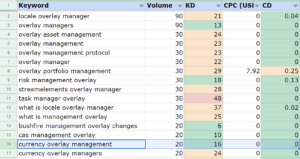Competitor SEO Analysis is an in-depth analization that assesses the search engine optimization strategies employed by your industry competitors. Understanding how your competitors are performing in organic search can offer valuable insights into market dynamics, keyword opportunities, content gaps, and link-building prospects.
Components of SEO Competitor Analysis will reflect the types of analysis completed during the audit.
The types of SEO analysis generally included are:
- Keyword
- On-page
- Off-page
- Technical
- Content
- UX
- Local (if applicable)
- International (if applicable)
Let’s cover each one of those components in more detail.
Keyword Analysis
- Primary Keywords: Identify the main organic keywords that your competitors are competing for, their keyword difficulty, and volume potential.
- Long-Tail Keywords: Uncover the less competitive keywords they are using to attract niche traffic with better conversion rates.
- Keyword Gap Analysis: Discover keywords that you haven’t targeted but your competitors have.

On-Page SEO Analysis
- Meta Descriptions and Titles: Analyze the meta HTML elements for optimization and keyword inclusion.
- Content Quality: Evaluate the depth, relevance, and uniqueness of SEO competitors’ content.
- Internal Linking: Understand how they are interlinking their pages for on-page SEO benefit.
Off-Page SEO Analysis
- Backlink Profile: Examine the quantity, quality, and source of backlinks contributing to off-page SEO.
- Domain Authority (DA): Compare the DA scores to gauge the website’s reputation and trustworthiness.
- Social Signals: Check social media presence and its impact on SEO.
Technical SEO Analysis
- Website Architecture: Identify the site architecture models used to develope the URLs of SEO competitors.
- Website Speed: Evaluate the loading speed of competitor websites on both desktop and mobile.
- Mobile Optimization: Assess how well the website performs on mobile devices.
- Robots.txt and Sitemap: Check for these elements and how they are structured.
Content Strategy Analysis
- Topical Authority: Identify topics that certain competitors rank particularly well for.
- Content Types: Identify the types of content used—blogs, videos, infographics, etc.
- Content Length: Compare the average content length with your own content.
- Content Clusters: Identify how compeitors are grouping, linking, and organizing their content.
- Frequency: Note the regularity of content updates.
User Experience (UX) Analysis
- Navigation: Analyze the site structure and ease of navigation.
- Bounce Rate: Check analytics tools to find publicly available data on their bounce rates.
- Calls to Action (CTA): Evaluate the effectiveness of CTAs in guiding user behavior.
Local SEO Analysis (if applicable)
- Google Business Profile (GBP): If applicable, analyze their Google Business Profile listings.
- Other Citations: Though GBP is the most popular citation site on the web, there are others that contribute to off-site SEO as well.
- Local Keywords: Note any geographically targeted keywords they’re ranking for.
- Local Backlinks: Assess backlinks coming from local businesses and publications.
International SEO Analysis (if applicable)
- Hreflang Tags: Inspect how your competitors use hreflang tags to tell search engines about the language and regional targeting of a webpage.
- Localized Keywords: Analyze if they are targeting keywords in different languages or specific to certain regions.
- Local Search Engines: Determine if they are optimizing for search engines other than Google, like Baidu in China or Yandex in Russia.
- Content Localization: Evaluate the quality and depth of content that has been localized for specific audiences.
- Country-Specific Domains: Check whether your competitors use country-specific domain extensions to appeal to international audiences, such as
.co.ukfor the UK or.cafor Canada. - Server Location: Note if they are using localized server hosting to improve website load speed in targeted countries.
- Local Partnerships and Backlinks: Assess if they’ve developed partnerships or garnered backlinks from websites in the countries they’re targeting, which could boost their SEO efforts locally.
- Cultural Sensitivity: Observe if the content and user interface reflect cultural preferences and norms for the target audience.
- Local Regulations: Check if the competitor’s international websites comply with local regulations and standards, such as GDPR in the European Union.
Why It Matters
Performing a thorough competitor SEO audit allows you to understand your competition’s strengths and weaknesses. This information is invaluable for optimizing your own SEO strategies. By identifying gaps in your competitor’s approach, you can find opportunities to outperform them in SERPs (Search Engine Results Pages).
For example, if a competitor ranks well but has poor mobile optimization, focusing on your site’s mobile experience could give you a significant edge. The key to a successful SEO campaign is not just knowing what you’re doing but understanding what your competitors are up to.
Remember, the digital landscape is always evolving. Therefore, make competitor SEO analysis a recurring task in your digital marketing strategy.
Schedule a Consultation
At SEO Succor, we offer SEO competitor analysis with all of our SEO campaigns.
Contact us today to learn more about how we can uncover the secrets of your SEO competitors.
Schedule a complementary consultation with one of our SEO experts.


